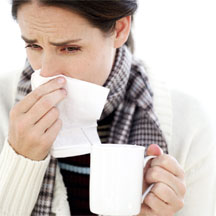 As temperatures go down, remember that the threat of the common cold and influenza traditionally rises. The nation’s emergency physicians want to make sure you know the difference between the two and what, if anything, you can do to prevent from getting either. Prevention is key.
As temperatures go down, remember that the threat of the common cold and influenza traditionally rises. The nation’s emergency physicians want to make sure you know the difference between the two and what, if anything, you can do to prevent from getting either. Prevention is key.
Flu
Seasonal influenza, which is commonly known as “the flu” may affect between five to as high as 20 percent of the U.S. population depending on the year, according to the Centers for Disease Control and Prevention (CDC). More than 200,000 people are hospitalized each year for flu-related complications and about 36,000 people die each year from the flu.
Signs and symptoms of the flu may include:
- High fever (usually 100 degrees F to 103 degrees F in adults and often higher in children)
- Chills
- Headache
- Fatigue
- Muscle Aches
- Dizziness
- Loss of appetite
- Dry cough
- Sore throat
- Runny or stuffy nose
- Weakness
- Ear Infection
- Diarrhea
Call your primary care doctor or go to the nearest emergency department if you feel it’s necessary and if symptoms are severe or worsen. You should also call for vaccine inquiries.
Common Colds
Colds are far less serious than the flu and may be treated with over-the-counter decongestants, cough medicines or plain old rest and fluids. If you choose to use medications, follow the instructions on the label carefully. The best way to prevent colds is to wash your hands regularly and avoid contact with people who have colds or other upper respiratory infections.
Signs and symptoms of colds include:
-
•
- An initial tickle in the throat
- A runny or stuffy nose and sneezing
- Cough
- Sore throat
- Headache
- Mild fever
- Mild fatigue
- Mild muscle aches
- Loss of appetite
- A change in nasal discharge from watery to thick yellow or green.
•
•
•
•
•
•
•
•
•











